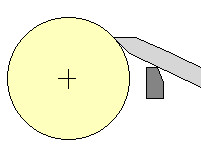6.6 The concept of the rubbing bevel
In the foregoing I have referred to the need to keep the bevel flat (ie, rubbing) on the wood. For convenience it has also been assumed that the wood is flat. On a flat section of wood either the whole of the bevel must rub or none of it. But on a curved piece of wood (and most surfaces of a piece of turnery are curved) it would seem to be impossible for the whole of the of the bevel to rub. On an inside curve, e.g. on the inside of a bowl, there will be contact at two points, on the cutting edge and on the heel. In theory, on an outside curve only a small part of the bevel, that adjacent to the cutting edge, can be in contact with the wood. Nevertheless, it can be argued that the concept of the rubbing bevel is one of the most important in the woodturning process.
Some years ago there was a debate in one of the woodworking magazines (in the UK) between two experienced turners; one of them insisted that the bevel must rub all of the time the other disagreed strongly.
The crux of this argument depends, not surprisingly, on what is meant by the bevel: is it the whole of the bevel or only a small portion of it? On an inside curve the two points referred to above, ie the edge and the heel, should be in contact. On an outside curve the bevel should lie on the tangent to the surface at the point being cut (see Diagram 6.4). In such a case the bevel is providing less assistance to the control of the cut.

Diagram 6.4 The bevel rubbing on an outside curve
As a consequence it is easy for the beginner to lapse into a scraping action, particularly with the roughing gouge. For this reason, when spindle turning it is often found beneficial to hold the cutting edge of the tool at an angle to the axis of the lathe whilst moving the tool in the direction in which it is pointing (see Section 10.3). This has the effect of flattening the curvature of the wood; as consequence the bevel has more support.
There is, however, a practical aspect of this which needs to be considered. This is that the wood is often soft enough to deform slightly under the force of the cut. As a consequence if the curvature of the wood is not too great the bevel is pressed into the wood, so making greater contact. The effect of this can often be seen in the way the wood is burnished smooth. Sometimes the smooth finish will be slightly marred by scratches made by the heel of the bevel where it has been pressed into the wood. This is proof (if any is required) that the bevel has been rubbing along all of its length.
Some qualification of the term 'rubbing' is required - what it really means is keeping the bevel flat on the wood. It does not mean that it should always be pressed down hard on the wood. Sometimes it is necessary for the bevel to just brush the wood.
© Brian Clifford (June 1999)
Home | Intro to WT